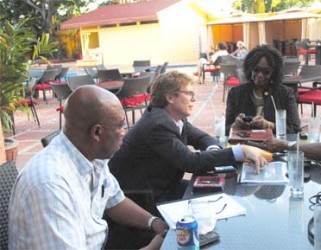The Canada-based gold mining company Guyana Goldfields, which has been working to advance and develop its Aurora Gold Project here since 1996, last week committed to a time frame of “the first quarter of 2015” for the production of gold in Guyana.
The announcement that the company had adjusted its production time frame from 2014 to 2015 immediately attracted a comment from Natural Resources and Environment Minister Robert Persaud urging that ways be examined to revert to the original production time frame.

The company’s Chief Executive Officer Patrick Sheridan told Stabroek Business in an exclusive interview a week ago that the revision of the startup time for gold production arose out of deficiencies in a “non-optimised feasibility study published last year.
“In retrospect it [the outcomes of the study released in 2012]… was rushed and I do not think that proper guidance was given to the engineers, in the sense that they worked in isolation. One team was doing the mine plan, one team was concentrating on tailings. There was no cohesiveness in the study. There was no guidance and instruction given to them,” Sheridan told Stabroek Business. “What we ended up with in the April study at the end of the day was a project that, in my view and in the view of many in the industry, did not reach its full potential both in terms of profitability and in terms of its approach to the mine plan itself.”
And while the Guyana Goldfields top executive conceded that there were deficiencies in the study released last year he said, nonetheless, that the Aurora gold project represented a landmark development both for the country’s mining sector and for collaboration with Guyana Goldfields. “At some stage the gold near the surface in all parts of the world becomes more and more difficult to find and I think that what we clearly demonstrated is that in Guyana there is potential for open pit mining and more importantly, in the long term, for underground mining,” Sheridan said.
Sheridan told Stabroek Business that the revised perspective arising out of last week’s announcement of a 2015 production time frame resulted from Guyana Goldfields having gone back “from ground up” to re-design the mine “taking into account all of the local factors but also more importantly looking at optimising ounces produced and finding that middle ground where a significant amount of gold is produced, but the mine is more efficient, more optimal, more profitable.”
Sheridan said that the release made by Guyana Goldfields last week contained what he described as “major improvements” including the re-design of the open pits in what he described as a much more efficient manner. He said that while the 2012 study indicated that nine tonnes of waste had to be moved in order to access one tonne of ore, the new study indicates the only 4.7 tonnes of waste have to be removed to secure the same tonne of ore.
And in what Guyana Goldfields is treating as a key development arising out of the new study, Sheridan told Stabroek Business that the company had secured a 60 per cent reduction in capital costs, from US$525 million to US$205 million, “for getting the mine up and running.”Additionally, he said that while the study released in 2012 pointed to a return after taxes of what he described as a “not very attractive” 12%, the more recent study points to a return of about 40%. “In this day and age you have to show attractive returns. The reality is that in less developed countries you have to have a premium for the risks that will inevitably exist,” Sheridan said.
Stabroek Business has learnt that Guyana Goldfields’ decision to take the outcome of the feasibility study released last year back to the drawing board has met with the approval of the company’s shareholders.
Sheridan said the more recent feasibility assessment of the Aurora gold project also points to shrinkage of the project’s “environmental footprint” given the fact that more gold would now be mined underground. Aurora’s revised mine plans, according to Sheridan, “call for production of approximately 3.25 million ounces over a 17-year mine life. Average annual production for the life of the mine is about 190,000 ounces but ordinarily the production in the first ten averages about 220,000 ounces. He said that in 2020, Guyana Goldfields’ projected peak production year, gold yield is estimated to reach 360,000 ounces, about 80 per cent of Guyana’s declared gold production for 2012.
Guyana Goldfields estimates that it will invest US$740 million in the project over its lifetime. Sheridan told Stabroek Business that the company’s profits in the first two years will be re-invested into the project and will target the development of the underground mine and doubling milling capacity.
And according to Sheridan, the commencement of Guyana Goldfields’ mining operations here will not only witness the introduction of a new regimen of technology and techniques for underground mining but will also attract other foreign investors to the sector. “Our model clearly shows there is potential for these things to happen,” he said.
Guyana Goldfields’ mine plan includes “an initial underground exploration phase to be lead by expatriates, primarily Canadian underground mining contractors. Over time we envisage that the skills will get transferred and Guyanese will come in and replace the expatriates,” he said.
Sheridan disclosed that Guyana Goldfields will be seeking to set up training programmes for open-pit mining operations. “In fact it is in our mining contract that we would have to use Guyanese labour so that it is in our interest to have these training programmes,” Sheridan said.





